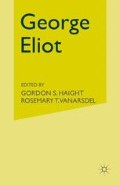Abstract
We know from George Eliot’s notes for Adam Bede1 that, from the beginning of her career as a novelist, she was characteristically careful about introducing anything into her fiction that she did not thoroughly understand. In that novel, before dressing her characters in the fashion peculiar to the turn of the century, she read and took notes from Fairholt’s Costume in England.2 From hose to headgear Hetty Sorrel attempts to be a fashionable lady on a milkmaid’s pay. She even manages to buy herself a pair of large earrings, which were all the rage in 1799;3 so that when the novelist designed a moral motif related to jewelry she made sure, first of all, that she had the correct design for the earrings themselves.4 When writing Romola Eliot took infinite pains to get similar details accurately transcribed before turning them into the patterns of fiction.
Access this chapter
Tax calculation will be finalised at checkout
Purchases are for personal use only
Preview
Unable to display preview. Download preview PDF.
Notes
Joseph Wiesenfarth, ‘George Eliot’ Notes for Adam Bede’, Nineteenth-Century Fiction, 32 (1977), 127–65.
For a discussion of the distinction between Hetty and Dinah Morris suggested by the jewellry motif in Adam Bede, see Bonnie S. Zimmerman, ‘“Radiant as a Diamond”: Jewelry and the Female Role’, Criticism, 19 (1977), 212–22.
C[harles] W[illiam] King, Antique Gems: Their Origin, Uses, and Value as Interpreters of Ancient History; and as Illustrative of Ancient Art; with Hints to Gem Collectors (London: John Murray, 1860). George Eliot took copious notes from King’s work and entered them into her Commonplace Notebook.
see George Eliot, A Writer’s Notebook, 1854–1879, ed. Joseph Wiesenfarth (Charlottesville, Va.: University Press of Virginia, 1981), pp. 75–82; hereafter cited as Notebook.
A different interpretation is proposed by Felicia Bonaparte: ‘ The intaglio of a fish with a crested serpent above it on Tito’s ring … suggests Bacchus, the epiphanic god of the sea who numbers among his specific creatures the serpent’ (The Triptych and the Cross: The Central Myths of George Eliot’s; Poetic Imagination, The Gotham Library [New York: New York University Press, 1979], p. 91).
George Eliot, Middlemarch, ed. Gordon S. Haight, Riverside Editions (Boston: Houghton Mifflin, 1956), p. 10; subsequent references are to this edition.
Daniel Deronda, ed. Barbara Hardy (Harmondsworth: Penguin Books 1967), Ch. 31, p. 406.
On the jewelry motif in general in this novel see Albert R. Cirillo, ‘Salvation in Daniel Deronda: The Fortunate Overthrow of Gwendolen Harleth’, Literary Monographs, ed. Eric Rothstein and Thomas K. Dunseath (Madison, Milwaukee, London: University of Wisconsin Press, 1967), i, 201–44; esp. pp. 213–16.
For an extended discussion of the use of the Jason — Medea — Creusa analogy in Deronda, see Joseph Wiesenfarth, George Eliot’s Mythmaking, Reihe Siegen 1 (Heidelberg: Carl Winter, 1977), pp. 215–19.
Editor information
Editors and Affiliations
Copyright information
© 1982 Gordon S. Haight and Rosemary T. VanArsdel
About this chapter
Cite this chapter
Wiesenfarth, J. (1982). Antique Gems from Romola to Daniel Deronda. In: Haight, G.S., Van Arsdel, R.T. (eds) George Eliot. Palgrave Macmillan, London. https://doi.org/10.1007/978-1-349-05969-0_6
Download citation
DOI: https://doi.org/10.1007/978-1-349-05969-0_6
Publisher Name: Palgrave Macmillan, London
Print ISBN: 978-1-349-05971-3
Online ISBN: 978-1-349-05969-0
eBook Packages: Palgrave Literature & Performing Arts CollectionLiterature, Cultural and Media Studies (R0)

